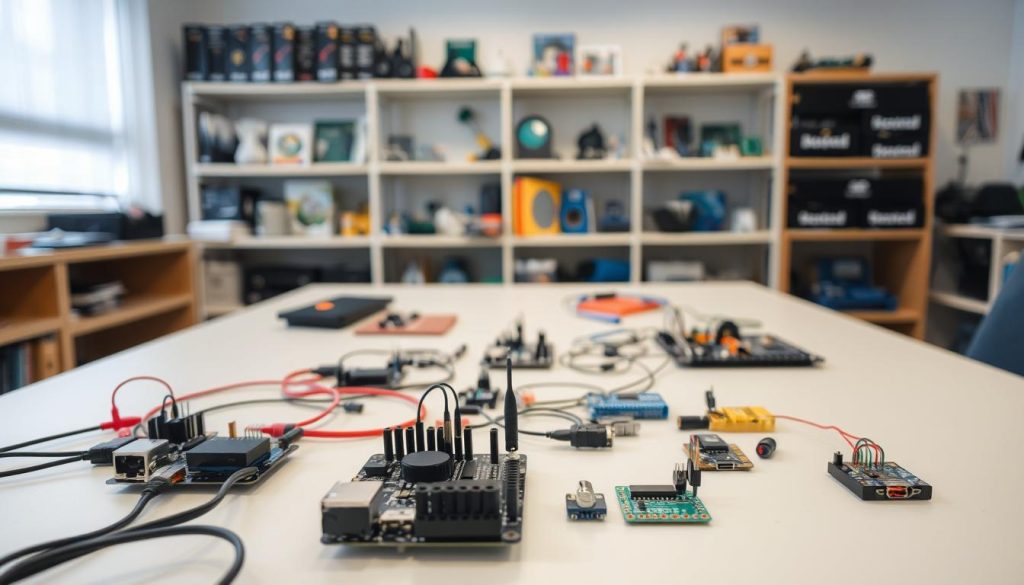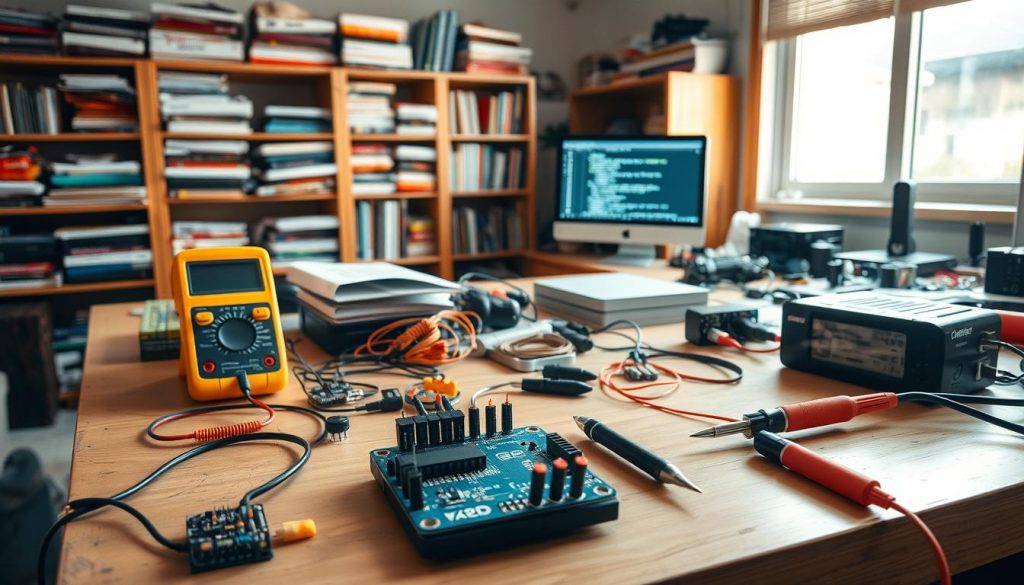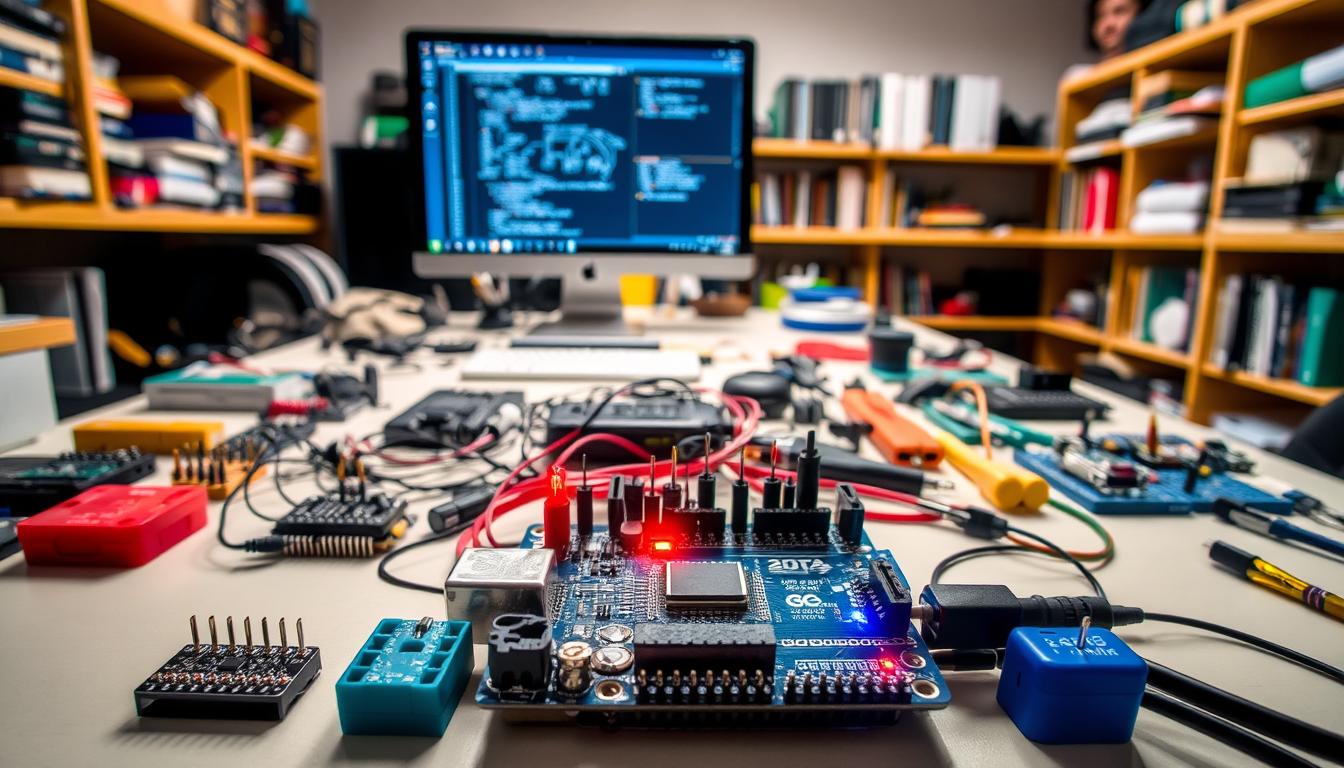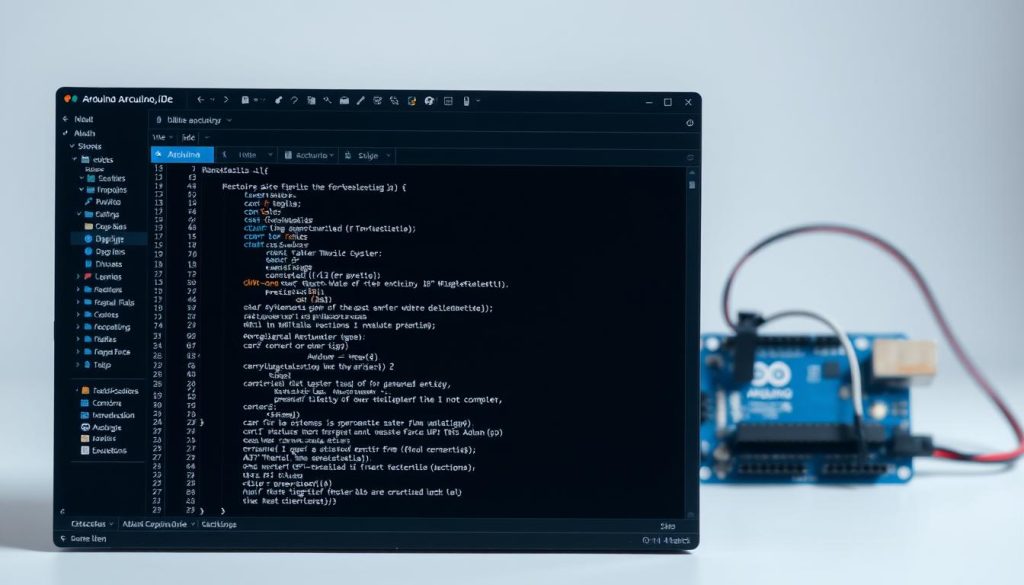Are you ready to unlock the full potential of your creativity with interactive and innovative applications? Imagine being able to control and automate various aspects of your life with just a few lines of code and some clever circuitry.
Interactive technology is revolutionizing the way we live, and DIY enthusiasts are at the forefront of this movement. With an open-source platform, users can create a wide range of applications, from simple home automation systems to complex robotics.
This versatility has made it a favorite among hobbyists, students, and professionals alike, offering a friendly and engaging way to explore the world of interactive technology.
Key Takeaways
Table of Contents
- Explore the world of interactive technology with an open-source platform.
- Create a wide range of applications, from simple home automation to complex robotics.
- Discover innovative project ideas to spark your creativity.
- Learn how to control and automate various aspects of your life.
- Unlock the full potential of your DIY projects.
Understanding the World of Arduino
Arduino has revolutionized the way we approach electronics projects, making it more accessible than ever. At its core, Arduino is an open-source electronics platform that enables users to create interactive projects. This platform is built around a microcontroller board, which is the brain of any Arduino project.
What is Arduino and Why It’s Revolutionary
Arduino is a microcontroller platform that simplifies the process of creating electronic projects. It’s revolutionary because it provides an affordable and user-friendly way to bring ideas to life. With Arduino tutorials and Arduino programming resources readily available, beginners can quickly get started. The Arduino community is vast and supportive, offering numerous Arduino project kits for various skill levels.
Essential Tools and Components You’ll Need
To start working with Arduino, you’ll need a few essential tools and components. The Arduino board is the centerpiece, but you’ll also require a breadboard for prototyping, LEDs, resistors, and jumper wires.
Having the right tools and components on hand will make it easier to complete projects and learn the basics of electronics.
Some recommended starter kits include the Arduino Uno, a breadboard, and a variety of sensors and actuators. These kits are designed to introduce you to the fundamentals of Arduino programming and electronics.
Setting Up Your Arduino Environment
The first step in exploring Arduino is to establish a functional environment. This involves several key steps that will get you ready to start working on your DIY Arduino projects.
Arduino Board Types and Selection
Arduino offers a variety of boards, each with its unique features and applications. The most popular boards include the Arduino Uno, Arduino Mega, and Arduino Nano. When selecting a board, consider the project’s requirements, such as the number of input/output pins, memory, and processing power.
| Board Type | Microcontroller | Digital I/O Pins |
|---|---|---|
| Arduino Uno | ATmega328P | 14 |
| Arduino Mega | ATmega2560 | 54 |
| Arduino Nano | ATmega328P | 14 |
Installing and Configuring the Arduino IDE
The Arduino IDE is the software that allows you to write, compile, and upload code to your Arduino board. To install the IDE, download it from the official Arduino website and follow the installation instructions. Once installed, familiarize yourself with the IDE’s interface and configure it according to your board’s specifications.
Understanding Basic Circuit Connections
Understanding how to connect components to your Arduino board is crucial. Basic connections include power, ground, and signal pins. It’s essential to understand the role of breadboards and jumper wires in creating temporary circuits for testing and prototyping your Arduino projects for beginners.
By following these steps, you’ll be well on your way to setting up a functional Arduino environment and starting your arduino programming journey.
Beginner-Friendly Arduino Electronics Projects
Embark on your Arduino journey with three exciting beginner-friendly projects that will spark your creativity and enhance your skills. These projects are designed to introduce you to the fundamentals of Arduino programming and electronics. By completing these projects, you’ll gain hands-on experience and build a solid foundation for more complex endeavors.
Project 1: LED Blinking and Patterns
Start with a simple yet enlightening project: creating an LED blinking circuit. This project is an excellent introduction to programming and basic electronics. You’ll learn how to write code to control the LED’s behavior, creating various blinking patterns. As “the journey of a thousand miles begins with a single step”, this project is your first step into the world of Arduino.
Project 2: Digital Thermometer with LCD Display
Next, you’ll build a digital thermometer with an LCD display. This project teaches you how to integrate a temperature sensor with your Arduino board and display the readings on an LCD screen. It’s a great way to learn about sensor integration and data visualization. You’ll be able to monitor the temperature in real-time, making it a practical and engaging project.
Project 3: Motion-Activated Alarm
Finally, create a motion-activated alarm to learn about sensor-based interactions. This project involves using a motion sensor to trigger an alarm, teaching you how to respond to environmental changes with your Arduino board. It’s a fun and interactive way to explore the capabilities of Arduino.
Step-by-Step Guide to Intermediate Projects
Now that you’ve grasped the basics, let’s dive into intermediate Arduino projects that will enhance your coding and circuitry abilities. These projects are designed to challenge your skills and introduce you to more complex applications of Arduino technology. By completing these projects, you’ll gain hands-on experience with advanced concepts and components.
Project 4: Automated Plant Watering System
The Automated Plant Watering System is a practical project that utilizes Arduino to monitor soil moisture levels and water your plants accordingly. This project involves integrating a soil moisture sensor, a water pump, and writing code to automate the watering process based on the moisture levels detected. It’s an excellent way to learn about sensor integration and automated control systems.

Project 5: Ultrasonic Distance Measurement
Ultrasonic Distance Measurement is another fascinating project that demonstrates how Arduino can be used to measure distances using ultrasonic sensors. This project involves connecting an ultrasonic sensor to your Arduino board and writing code to calculate and display the distance measured. It’s a great way to understand how to work with sensors and interpret their data.
Project 6: Servo Motor Control System
The Servo Motor Control System project teaches you how to control servo motors using Arduino, allowing you to create projects that involve precise motor control, such as robotic arms. This project requires understanding how to connect servo motors to Arduino and writing code to control their movement. It’s an excellent introduction to robotics and motor control.
| Project | Key Components | Skills Learned |
|---|---|---|
| Automated Plant Watering System | Soil Moisture Sensor, Water Pump | Sensor Integration, Automated Control |
| Ultrasonic Distance Measurement | Ultrasonic Sensor | Distance Measurement, Sensor Data Interpretation |
| Servo Motor Control System | Servo Motor | Motor Control, Robotics |
Creating Advanced Arduino Electronics Projects
As you progress in your Arduino journey, it’s time to tackle more complex projects that challenge your skills and expand your knowledge. Advanced Arduino electronics projects not only enhance your understanding of electronics and programming but also enable you to create innovative solutions for real-world problems.
Let’s dive into three exciting projects that showcase the capabilities of Arduino in advanced applications.
Project 7: Weather Station with Data Logging
A weather station with data logging is a fascinating project that involves collecting and recording environmental data such as temperature, humidity, and pressure. By integrating sensors like the DHT11 and BMP180, you can create a comprehensive weather monitoring system. The data can be logged onto an SD card or transmitted wirelessly for further analysis.
Project 8: Bluetooth-Controlled Robot Car
Building a Bluetooth-controlled robot car is an engaging project that combines motor control, Bluetooth communication, and Android app development. Using an Arduino board, an L298N motor driver, and a Bluetooth module, you can create a robot that can be controlled remotely using a smartphone app. This project enhances your understanding of wireless communication and robotics.
Project 9: Home Automation with Sensors
Home automation is a practical application of Arduino that involves controlling household devices based on sensor inputs. By integrating sensors like PIR motion detectors and light sensors, you can automate lighting, heating, and security systems. This project not only adds convenience to your home but also provides a deeper understanding of sensor integration and automation.
| Project | Components | Skills Learned |
|---|---|---|
| Weather Station | DHT11, BMP180, SD Card | Data Logging, Sensor Integration |
| Bluetooth-Controlled Robot Car | L298N, Bluetooth Module | Motor Control, Wireless Communication |
| Home Automation | PIR Sensor, Light Sensor | Automation, Sensor Integration |
Troubleshooting Your Arduino Projects
When working on Arduino projects, troubleshooting is an essential skill to master. Whether you’re a beginner or an experienced maker, issues can arise that require careful diagnosis and repair.
Diagnosing Common Hardware Issues
Hardware issues can often be traced back to simple problems such as loose connections or incorrect component usage. Check your connections and ensure that all components are correctly installed. Using Arduino project kits can help minimize these issues as they usually come with pre-assembled components.

Fixing Programming Errors and Debugging Tips
Programming errors are common in Arduino programming, but the Arduino IDE provides tools to help debug your code. Use the serial monitor to print out variable values and check your code logic. Following Arduino tutorials can also improve your programming skills and reduce errors.
Safety Considerations When Working with Electronics
Safety should always be your top priority when working with electronics. Ensure you’re working in a well-ventilated area, and avoid touching electrical components with your bare hands. Using proper safety gear like gloves can prevent accidents.
Expanding Your Arduino Skills and Knowledge
As you continue to explore the world of Arduino, it’s essential to expand your skills and knowledge. Engaging with the Arduino community and accessing various learning resources can significantly enhance your project development capabilities.
Best Online Communities and Forums
Joining online forums such as the Arduino Forum and Reddit’s r/Arduino can provide valuable insights and support. These platforms allow you to share your projects, ask questions, and learn from experienced Arduino enthusiasts.
Recommended Books and Courses
For those looking to deepen their understanding, books like “Getting Started with Arduino” and online courses on platforms like Udemy and Coursera are highly recommended. These resources cover a wide range of topics, from basic to advanced Arduino projects.
Project Ideas for Further Exploration
Consider exploring Arduino project ideas such as home automation systems, robotic arms, and environmental monitoring stations. These projects not only challenge your skills but also provide practical applications for your knowledge.
By leveraging these resources and continuously challenging yourself with new Arduino coding projects, you’ll be well on your way to becoming proficient in Arduino development.
Conclusion
As we’ve explored throughout this article, Arduino electronics projects offer a vast playground for creativity and innovation. From simple LED blinking projects to complex home automation systems, the world of Arduino is full of exciting possibilities.
By working through the various arduino tutorials and projects, you’ve not only gained hands-on experience with arduino programming but also developed a deeper understanding of electronics and circuitry.
As you continue on your Arduino journey, remember that the learning process doesn’t stop here. There are countless arduino electronics projects waiting to be discovered, and the Arduino community is always ready to support and inspire you.
Whether you’re a hobbyist, student, or professional, the skills you’ve developed will open doors to new and exciting opportunities in the world of electronics and beyond.

